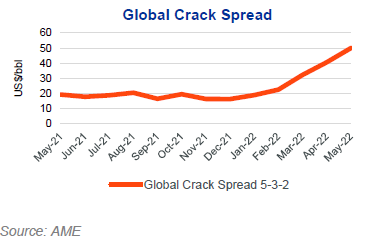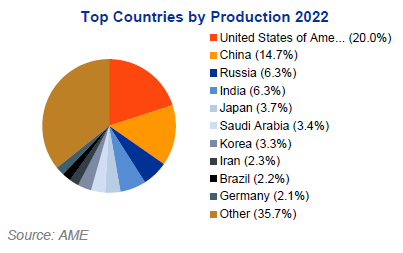Rapidly
increasing crude oil prices typically reduce product crack spreads, but
lower-than-average inventories are supporting higher crack spread prices.
Despite
high crude oil input costs for refineries, the price of refined products has
risen more than 45% this year, increasing the spread and beefing up the bottom
line for refiners. The crack spread price will remain very high through the
summer driving season as fuel demand peaks. Inventories of critical fuels are
also at near historic lows. Refining profits are
surging globally on fears of a potential gasoil shortage, as buyers avoid
Russian supplies despite soaring feedstock costs elsewhere.
AME
forecasts average prices will decline from US$34/bbl in 2023 to US$23/bbl in
2024, supported by a steady rebound in China’s demand for petrochemicals and
fuels. AME's global 5-3-2 crack spread averaged US$49.9/bbl in May, increasing
by 120% from the February average of US$22.5/bbl.
Refining margins will see
seasonal gains, and the two-year outlook is positive as mobility demand, both
for driving and flying, increases. New capacity additions in 2022 and increased
global runs will outpace the demand growth for refined products, leading to an
unwinding of some of the refinery margin gains from late last year.
Worldwide refiners are struggling to
meet global demand for diesel and gasoline, exacerbating high prices and
aggravating shortages from big consumers like the US and Brazil to smaller
countries like the Ukraine and Sri Lanka.
In May, the Reformulated Blendstock for
Oxygenate Blending (RBOB) gasoline average price was US$160.3/bbl, 39% higher
than February’s average of US$115.0/bbl. The US New York Harbour Ultra Low
Sulphur Diesel (NY ULSD) fuel average price was US$166.3/bbl, a 40% increase
from US$118.7/bbl in February.
Refiners globally are focussed on ESG
outcomes, targeting to lower Scope 1 and Scope 2 emissions. They are aiming to
achieve CO2 reduction through operational efficiency gains, increased
production of renewable fuels such as ethanol and renewable diesel, and CCS
programs. The transition will require significant capital investment and
additional costs. This adds pressure on simple and small refineries and will make
them less competitive in the long run.
Engaging with the energy transition,
Phillips 66's Humber refinery in the UK will integrate CO2 capture technology
with infrastructure to export CO2 into a proposed transport and storage
network. The Humber region produces 40% of the UK’s industrial CO2 emissions.
The project could provide a model for decarbonising refineries and make a
significant impact on the UK’s net-zero ambitions.
Saudi
Aramco is considering a joint project to build a 300kbpd refining and
petrochemical complex in Northeast China by 2024. The facility will help meet
the country’s growing demand for energy and chemical products.
Marathon is
aiming to reduce Scope 1 and 2 emissions to 30% below 2014 levels achieving
20.9 tonnes of CO2 equivalent per thousand boe by 2030.

